
Losing your job can be hard and confusing. In 2022 alone, the total number of layoffs and discharges in the US reached 17.6 million. You may be wondering: can you sue for being fired? In this article, we’ll focus on what to do if you’ve been illegally dismissed. We’ll guide you on how to identify if you have grounds for suing for wrongful termination, how to file a lawsuit, and what to expect during the trial. So, let’s get started!
Let’s begin by finding out if your job loss was unfair.
A severance agreement is a legal contract between an employer and an employee that outlines the termination terms. The agreement must provide for “compensation”. That is something of value beyond what the employee is already entitled to, such as a lump sum payment or extra benefits.
A typical severance agreement includes
For a waiver in a severance agreement to be valid, it must meet certain criteria:
In the case of group dismissals, employers should provide information about the selection process. This includes information about:
If the employer violates these conditions, it may be a sign of wrongful termination. Let’s take a closer look.
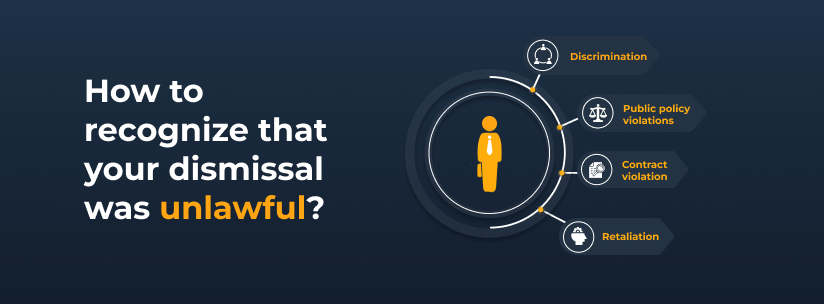
Wrongful termination happens when an employer fires an employee against the contract, laws, or policy.
It is important to note that most employment contracts in the US are at-will. This means that either the employer or the employee may stop the employment relationship at any time. But at-will employment is subject to specific exceptions that protect employees from wrongful termination.
Wrongful termination examples include:
Each of these points has its legal basis. Let’s analyze it in more detail.
It is illegal to discharge an employee based on discriminatory factors:
Title VII of the Civil Rights Act protects employees from termination due to discrimination. This applies regardless of whether they have an employment contract or not. More than 60% of all EEOC claims comply with this act.
The Age Discrimination in Employment Act (ADEA) protects individuals over the age of 40 from discrimination based on age. But it doesn’t apply to elected officials, members of the military, or non-U.S. citizens working outside the United States.
According to the Older Workers’ Benefits Protection Act (OWBPA), a waiver of an age discrimination claim must meet extra criteria:
Being dismissed due to mental or physical disability is also considered discrimination. The Americans with Disabilities Act (ADA) defines a person with a disability as an individual who
Under the ADA, employers cannot fire an employee because of their disability. It is also prohibited to dismiss because of the employer’s unwillingness to provide the necessary accommodations (if they do not create undue hardship on the business).
Dismissal due to pregnancy and sexual orientation is also considered discrimination.
Breach of contract occurs when one party fails to fulfill the terms agreed upon in the agreement. Thus, it is illegal to dismiss an employee in a manner that contradicts these conditions.
Examples include dismissal without an agreed notice period and without following the disciplinary procedure set out in the contract.
Unlawful retaliatory dismissal occurs when an employer fires or harasses an employee for engaging in legally protected activities.
This also includes asserting rights under labor law. For example:
When an employer retaliates against an employee for exercising these rights, it is wrongful dismissal. Even if the employee gives up these in the severance agreement, they can still file a claim with the EEOC. So they have the right to challenge discrimination without retaliation.
This occurs when an employer dismisses an employee for reasons that are contrary to the established public policy of the state or nation. Such policies often stem from laws, court precedents, and government regulations.
Common examples of public policy violations include:
An employee dismissed in violation of public policy may file a lawsuit for wrongful termination. The claim must prove that this case was directly related to the employee’s protected activity or refusal to violate the law.

Let’s summarize the laws under which you can file a lawsuit against your employer.
Title VII of the Civil Rights Act
Federal
Prohibits employment discrimination based on race, color, religion, sex, and national origin.
The Age Discrimination in Employment Act
Federal
Protects employees over the age of 40 from age-based discrimination.
The Americans with Disabilities Act
Federal
Prohibits discrimination against qualified individuals with disabilities.
State-Specific Employment Laws
State
Fair Employment and Housing Act (FEHA), New York State Human Rights Law, Texas Labor Code Chapter 21, Florida Civil Rights Act of 1992, Illinois Human Rights Act
Fair Labor Standards Act
Federal
Establishes minimum wage, overtime pay eligibility, recordkeeping, and child labor standards.
Public Policy Violations
State/Federal
Protects employees from termination for reasons that violate established public policy, like refusing to perform illegal acts.

Now we’ll delve into suing for wrongful termination. This includes reporting the unfair dismissal and filing a lawsuit. Here’s a step-by-step guide.

Start by reporting your dismissal to the relevant agency. You need to contact:
You can also report wrongful termination to your local Wage and Hour office.
Here is detailed information on how to sue a company for wrongful termination with the EEOC, OSHA, and the Department of Labor (DOL).
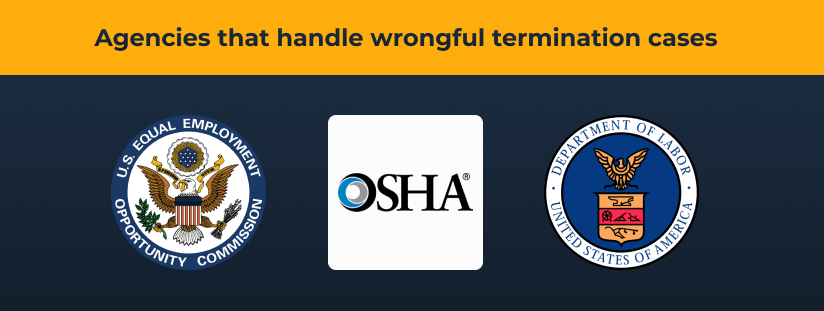
To file a discrimination complaint with the EEOC, you must
Note that, you must file a discrimination charge with the EEOC before you can submit a workplace claim against your employer. You can fill out this through the agency’s public portal after an online request and an interview with their staff.
When suing for wrongful termination with OSHA, you must
OSHA accepts complaints by mail, phone, in person, or through an online form on its website.
To file a complaint with the DOL, you must
Work with the DOL as they will help answer questions and determine if an investigation is the best course of action.
To prove the unlawfulness of a dismissal, it is important to show that the reason for the dismissal was unfair. This process usually consists of several key steps.
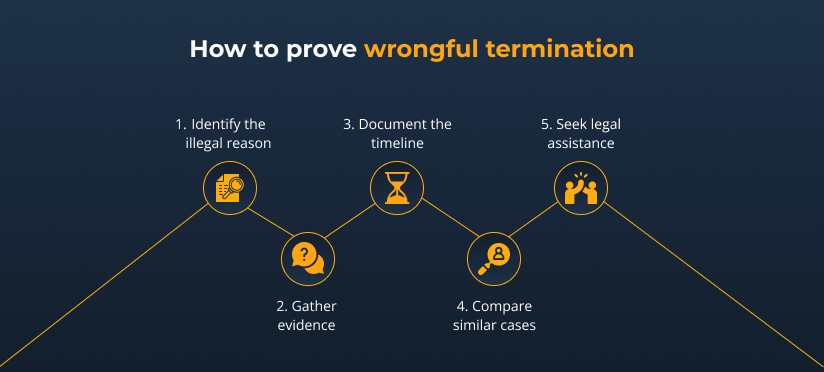
You need to collect:
If other subordinates were wrongly fired, ask them for proof too.
Contact your former coworkers. Document any discriminatory behavior, such as jokes about race or age, sexual harassment, or offensive emails. This may be grounds for a discrimination lawsuit.
Keep detailed records of the events leading up to the termination. This should include a timeline, notes about your employment and performance evaluations, and details about the “decision-making unit” in your dismissal.
The commission usually reviews your complaint. They conduct an investigation, which includes interviewing involved parties. They also offer mediation services to help resolve wrongful dismissal cases without going to court. This involves negotiations between you and your employer with the help of a third-party mediator.
If your case is a valid one and you decide not to use a mediator, it is advisable to consult with attorneys for wrongful termination. They can tell you about your options and the legal process.

Check out our article “How Much Does a Felony Defense Attorney Cost? Current Rates“
Now let’s find out what kind of compensation you can expect if your claim succeeds.
It is worth noting that compensation for emotional distress also requires proof. You will need to collect doctor’s notes, witness statements, etc.
Settlements in suing for wrongful termination range between $5,000 and $80,000, although the exact amount can vary.
Average compensation is around $37,200, with many cases falling in this range. But, the final amount depends on many factors, including the nature of the wrongful termination, the financial impact on the employee, and the case’s unique circumstances.
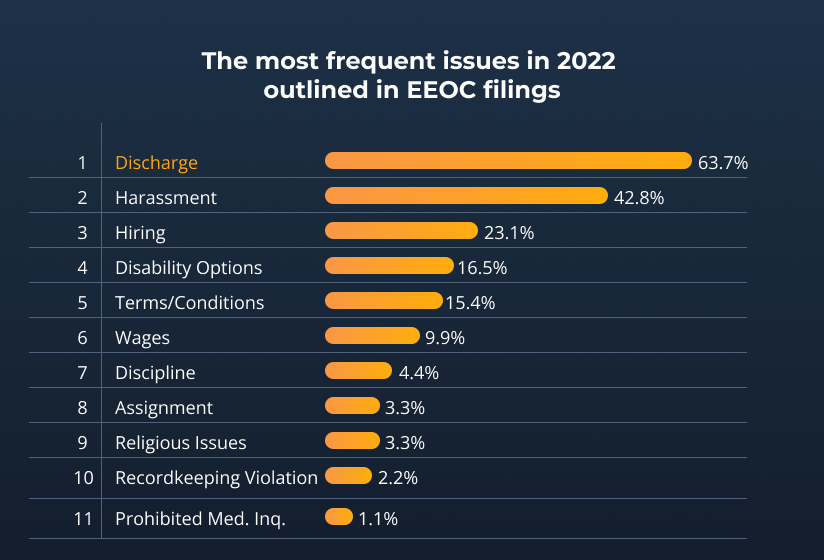
In 2022, the EEOC received 73,485 new discrimination charges, showing an almost 20% increase compared to the previous year. Wrongful termination was the most frequent issue among these appeals, accounting for 63.7% of all claims filed. But let’s see what you should expect if you complain to this agency.
If the EEOC has investigated your case and found it to be a labor law violation, the success rate in court is 96%. However the organization handles 91,7% of claims out of court. So, only 8.3% went to trial.
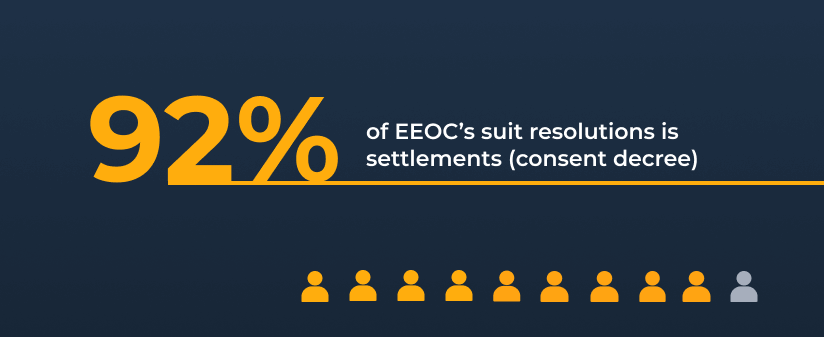
In 2022, the EEOC resolved 96 employment discrimination lawsuits. They obtained under $40 million in monetary relief for 1,461 individuals. The average payout is over $27,000.
But the agency sets limits on how much a business can compensate a victim depending on its size:
The goal of the EEOC is to return the victim to an environment as if they had never been discriminated against. So, if a person experiences an unlawful termination, the organization demands compensation for downtime, and stress, and even an offer to find a new job for them.

Learn more about “Is Dumpster Diving Illegal in the US? What the Law Says“
These are examples of employees winning wrongfully fired lawsuits.
Ortiz v. Chipotle
$8 million
Wrongful termination with retaliation and pregnancy discrimination.
EEOC v. Home Depot
$100,000
Gender discrimination and retaliation leading to wrongful discharge.
EEOC v. Radio Shack
$187,706
Age discrimination and retaliation.
Liggins v. Archdiocese of Los Angeles
$3.6 million
Discriminatory termination based on pregnancy.
EEOC v. Honeybaked Ham
$370,000
Sexual harassment and wrongful termination.
Hoyt v. Target Stores
$200,000
Wrongful termination in violation of public policy.
Sample v. City of Sheridan
$33,588
Age discrimination, and retaliation.
If your employer discriminated, retaliated, or did any illegal things that led to your dismissal, you should consider suing for wrongful termination. To assert your rights and get compensation for unfair loss of employment, this step is key.
But remember, resolving these cases can be challenging, and less than 10% of all claims go to trial. You need to collect clear evidence and know which laws to use. So, to find out if you definitely have this case, consult a wrongful termination lawyer. Or you can contact us so that we can find professional for you.
Yes, compensation for wrongful dismissal is taxable. Damages received for economic losses, such as lost wages, are not excluded from gross income. Discrimination claims are also not excludable under IRC Section 104(a)(2).
In general, the statute of limitations provides for 2-3 years for filing a wrongful termination in court. However, if you want to file a claim for violation of Title VII of the Civil Rights Act, you have only 180 days.
More than 90% of complaints don’t go to court and result in a settlement. But the chance of winning a court case is about 62.5%. It depends on the level of legal representation and the individual circumstances of the case.
Yes, if you are sure that it was illegal or related to discrimination or retaliation.










